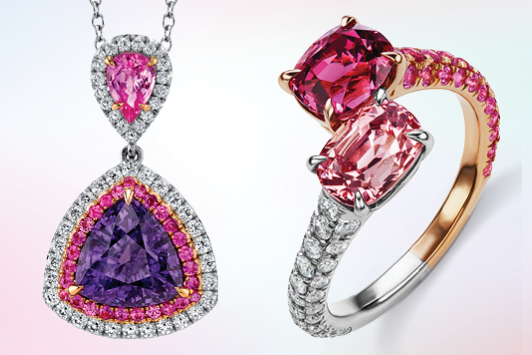 Images from left: Omi Privé, Alexia Connellan.
Images from left: Omi Privé, Alexia Connellan.
Some stones are worth all the hyperbole, and one of those stones is spinel. It ticks every box for what makes a desirable gem. An ancient mineral, spinel flaunts vivid, saturated hues in a cubic crystal formation. The natural stone is often transparent and usually needs no treatment. Its ranking of 8 on the Mohs hardness scale makes it ideal for every type of jewelry. The Burmese say these crystals are near perfect; they call them nat thwe, meaning “polished by the spirits.”
Early spinel deposits in central and southeast Asia produced sizable crystals called balas rubies, which kings and rulers guarded as spoils of war. Indeed, ancient mines offered gems to royalty from Europe to Asia, including spinel, which was often mistaken for other stones such as sapphire or ruby. Today, we know that many famed rubies were really spinels.
A touch of intrigue
“Spinel is the most versatile gemstone,” says Carl Larson, director of gems at colored-stone dealer Pala International. “It comes in all sorts of wonderful colors, with its luster rivaling corundum.”
But its charisma may actually lie in its secretive identity, he adds. “While ruby and sapphire have the heritage spinel lacks, its mystery as the impostor stone that tricked so many people over the years makes it the clever devil of gems.”
What drives a gemstone into the hearts of serious collectors is not just its visual appeal, but also its story — and spinel has romance and antiquity in spades. Gemologist-designer Loretta Castoro sees growing consumer interest. Clients are gravitating toward rare and distinctive gems, she notes, and spinel fits the bill — “from Vietnamese electric-cobalt-blue spinel...to the deep red spinel from Mogok, Myanmar, or the beautiful stones of Mahenge, Tanzania.”
Buying hurdles
Remarkably, this ancient stone has remained off the radar for many modern consumers. Dealers explain that sourcing top-quality goods can be tricky for the US market.
“Pricing is high due to lack of supply, mining difficulties, and the fact that much of the easy material is already mined,” says Jeremy Chalchinsky, vice president of sales at Color Source Gems. “Alluvial sources are dwindling, which increases the cost and reduces their availability.”
Both Larson and Castoro affirm that prices have exploded in recent years.
“Before, you could get spinel for $50 a carat,” recalls Larson, but now it’s more like $200 to $1,000 per carat. “Anything sizable, clean, and nice grey without purple will run you toward that $1,000-per-carat range.”
Quality spinel is harder to come by because there are so many almost-good stones available, he continues. “While off-color or included emeralds, sapphires and rubies hold their place in the trade as marketable, imperfect spinel is quite hard to sell, even at bargain prices.” This means he hunts for just top-tier stones, which are nearly impossible to acquire, since “they tend to sell immediately to big names for high per-carat prices.”
Of course, he adds, “if you are willing to pay a premium, then you can find what you are looking for. However, to stay in the realm of financial responsibility, one must be patient and look with keen eyes.”
What’s hot, what’s not
Much like fashion, gemstone colors wax and wane in popularity over time.
“Red always appeals. People want bright colors,” states Chalchinsky. While more nuanced shades gained attention years back, that train may have left the station; he’s found that raspberry, dark purples, and greys with lots of secondary colors are not that popular currently.
Paul Levin, owner of Tairona Gems, travels the globe sourcing gems like spinel. “Spinel was a very hot stone, especially in the pure greys to bluish-grey a couple of years ago. It sold very well for two years. However, in the past year, I have seen very little demand.”
Levin’s clients say their customers are not asking about greys as they did previously, and are not purchasing any more for stock. “When I was buying, I wanted very pure colors,” Levin recounts. “Greys with a lavender were hard to sell, while blue-grey or platinum grey sold well, but that was the top 5% of the material one could find.”
While some colored stones rely on legends and lore to pique the interest of consumers, spinel doesn’t need any such spin to prove its merit. By explaining that it’s a naturally colored stone with admirable transparency and the durability to last a lifetime, sellers can make end users understand its worth.
Levin’s suggested sales pitch says it all: “It’s used in the crown jewels, so why not on your princess?
Article from the Rapaport Magazine - November 2021. To subscribe click here.